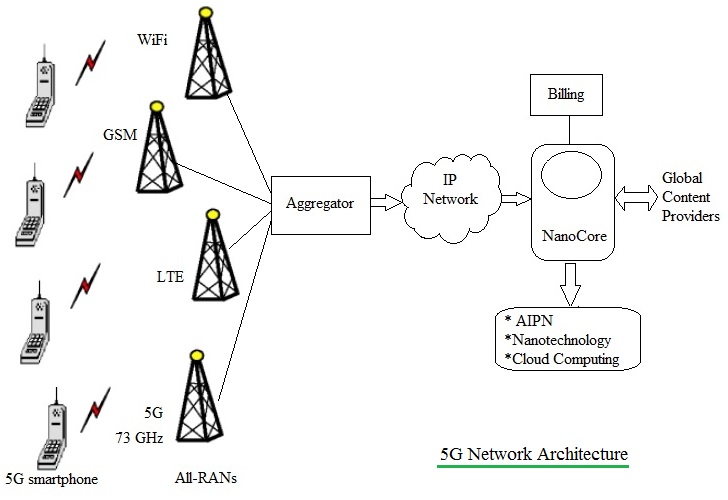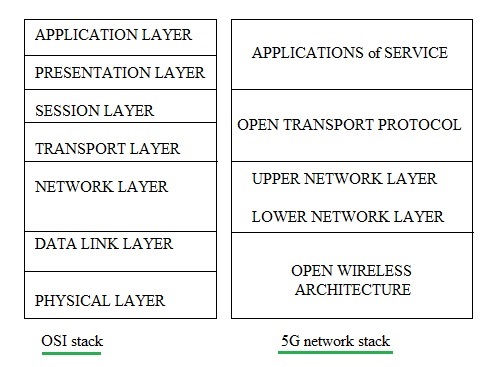5G network architecture | 5G Architecture
Mục Lục
5G network architecture | 5G Architecture
This page describes 5G network architecture with its elements.
The 5G architecture consists of all RANs, aggregator, IP network, nanocore etc. network elements.
5G NR (New Radio) architecture as per 3GPP document published in dec. 2017 is also described.
5G network architecture

Figure-1 depicts 5G network architecture. This is generic architecture. As shown 5G network uses flat IP concept so that
different RANs (Radio Access Networks) can use the same single Nanocore for communication.
RANs supported by 5G architecture are GSM, GPRS/EDGE, UMTS, LTE, LTE-advanced,
WiMAX, WiFi, CDMA2000, EV-DO, CDMA One, IS-95 etc.
Flat IP architecture identify devices using symbolic names unlike hierarchical architecture where in
normal IP addresses are used. This architecture reduces number of network elements in data path
and hence reduces cost to greater extent. It also minimizes latency.
5G aggregator aggregates all the RAN traffics and route it to gateway.
5G aggregator is located at BSC/RNC place.
5G mobile terminal houses different radio interfaces for each RAT in order to provide support for
all the spectrum access and wireless technologies.
Another component in the 5G network architecture is 5G nanocore.
It consists of nanotechnology, cloud computing, All IP architecture.
Cloud computing utilizes internet as well as central remote servers to maintain data and applications
of the users. It allows consumers to use applications without any installation and access
their files from any computer across the globe with the use of internet.
Refer Cloud storage tutorial➤ and
cloud computing tutorial➤ for more
information.
Global content service providers support following applications:
• Search engine• education• public portal• private portal• government•
medical• transportation• banking etc.
5G architecture as per 5G NR standard
5G NR overall architecture is shown in the following figure-2. This is as defined in the 3GPP TS 38.300 specification.

As shown in the figure, gNB node provides NR user plane and control plane protocol terminations towards the UE (i.e. 5G terminal device such as
smartphone, tablet, laptop etc.) and it is connected via the NG interface to the 5GC.
The ng-eNB node providing E-UTRA (i.e. LTE) user plane and control plane protocol terminations towards the UE,
and connected via the NG interface to the 5GC.
Here AMF stands for Access and Mobility Management Function and UPF stands for User Plane Function.
3GPP TS 38.401 describes 5G NR user plane and control plane as well as 5G NR RAN architecture with various interfaces (NG, Xn and F1) and their interaction with the radio interface (Uu).
The same have been depicted in the following figure-3 and figure-4. 5G smartphones interact with 5G-RAN over Uu radio interface.
5G RAN interacts with 5GC (5G Core Network).

The protocols over Uu and NG interfaces are categorized into user plane protocols and
control plane protocols.
User plane protocols implement actual PDU Session service which carries user data through the access stratum.
Control plane protocols control PDU Sessions and connection between UE and the network from
various aspects which includes requesting the service, controlling different transmission resources, handover etc.
The mechanism for transparent transfer of NAS messages is also included.

The NG-RAN consists of a set of gNBs connected to the 5GC through the NG interface.
An gNB can support FDD mode, TDD mode or dual mode operation. gNBs can be interconnected through the Xn interface.
A gNB may consist of a gNB-CU and one or more gNB-DU(s). A gNB-CU and a gNB-DU is connected via F1 interface.
NG, Xn and F1 are logical interfaces.
5GC (5G Core) Network architecture is highly flexible, modular and scalable.
It offers many functions including network slicing to serve vivid customer requirements.
It offers distributed cloud, NFV (Network functions virtualization) and SDN (Software Defined Networking).
5G Protocol Stack

The figure-5 below depicts 5G protocol stack mentioning 5G protocol layers mapped with OSI stack.
As whown 5G protocol stack consists of OWA layer, network layer, Open transport layer and
application layer.
OWA Layer: OWA layer is the short form of Open Wireless Architecture layer.
It functions as physical layer and data link layer of OSI stack.
Network Layer: It is used to route data from source IP device to
the destination IP device/system. It is divided into lower and upper network layers.
Open Transport Layer: It combines functionality of both transport layer and session layer.
Application Layer: It marks the data as per proper format required.
It also does encryption and decryption of the data.
It selects the best wireless connection for given service.
Refer 5G protocol layers >> for more information on
5G protocol stack layers viz. layer-1 (i.e. PHYSICAL Layer), layer-2 (i.e. MAC, RLC, PDCP) and layer-3 (i.e. RRC Layer).
5G NR Radio protocol architecture
Following figure-6 depicts radio protocol architecture of 5G NR (New Radio) as defined in 3GPP TS 38.300.

Protocol layers at UE and gNB side are shown in the figure for both user plane and control plane functionalities.
Other system network architectures
LoRa
LTE
WirelessHART
WiMAX
Zigbee
Satellite IoT
Smart Grid
GSM
GPRS
UMTS
Femtocell
5G NR Numerology | 5G NR Terminology
5G NR Control channels | 5G NR Traffic Channels | 5G NR Reference Signals and sequences
5G TECHNOLOGY RELATED LINKS
This 5G tutorial also covers following sub topics on the 5G technology:
5G basic tutorial
5G Frequency Bands
5G millimeter wave tutorial
5G mm wave frame
5G millimeter wave channel sounding
Difference between 4G and 5G
5G testing and test equipments
5G network architecture
5G NR Physical layer
5G NR MAC layer
5G NR RLC layer
5G NR PDCP layer
IoT Wireless Technologies
➤THREAD
➤EnOcean
➤LoRa
➤SIGFOX
➤WHDI
➤NFC
➤Lonworks
➤CEBus
➤UPB
RF Wireless Tutorials
Share this page
Translate this page















![Toni Kroos là ai? [ sự thật về tiểu sử đầy đủ Toni Kroos ]](https://evbn.org/wp-content/uploads/New-Project-6635-1671934592.jpg)


